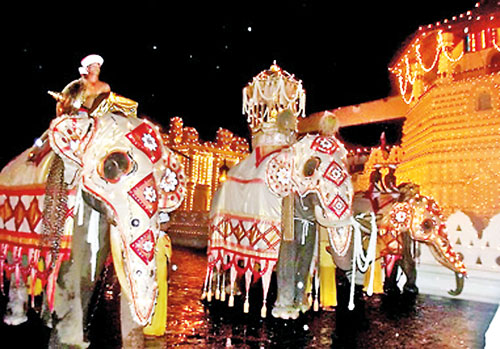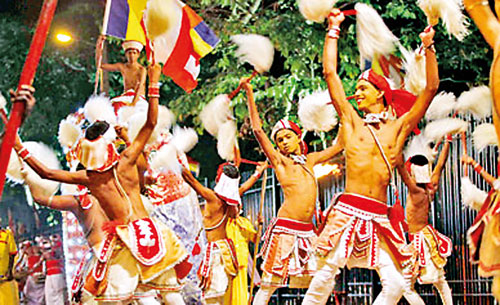Kandy in festive mood
 Poson Poya attracted devotees from all over the country to Anuradhapura and Mihintale to commemorate the introduction of Buddhism to Sri Lanka in the 3rd century BC. In the month of Esala (July/August) the accent shifts to Kandy, the last capital of the Sinhalese kings which still carries the name ‘Mahanuwara’ (main city) in Sinhala, for the annual cultural pageant paying homage to the Sri Dalada, the sacred Tooth Relic of the Buddha.
Poson Poya attracted devotees from all over the country to Anuradhapura and Mihintale to commemorate the introduction of Buddhism to Sri Lanka in the 3rd century BC. In the month of Esala (July/August) the accent shifts to Kandy, the last capital of the Sinhalese kings which still carries the name ‘Mahanuwara’ (main city) in Sinhala, for the annual cultural pageant paying homage to the Sri Dalada, the sacred Tooth Relic of the Buddha.
Continuing a tradition dating back to the 4th century AC when
King Sirimeghavanna (Kit Sirimevan 301 – 328 AC) started the annual festival of the Tooth Relic for the people to pay homage to the Tooth Relic, this year the Perahera customs begin on Sunday August 12, with the ‘Kapsituweema’ when a branch from a hallowed young jak tree is cut and planted in the premises of each of the four devales – Vishnu, Kataragama, Natha and Pattini, the last being the devale dedicated to goddess Pattini. This is followed by processions within the precincts of each devale until Thursday, August 16 when the Kumbal Perahera begins.
The Kumbal Perahera is held covering a few streets of the city until Monday, August 20.
The Randoli Perahera when the procession gets more glamorous, starts on Tuesday, August 21. The Perahera takes a longer route covering different streets each day. This is when crowds begin to flock.
The final Randoli Perahera in all its splendour is held on Saturday, August 25 – the Nikini Poya day with the water-cutting ceremony and the
Day Perahera the following day.
The Perahera
The Perahera begins with whip crackers announcing its arrival, the flag bearers follow in single file on either side of the road carrying the provincial and temple flags. The key Dalada Maligawa officials ride on gaily decorated elephants, the first being the ‘Peramune Rala’ carrying the ‘Lekam-mitiya’ – a manuscript with the names of the Maligawa lands and names of the service staff. Next come the ‘Gajanayaka Nilame’, chieftain in charge of elephants and ‘Kariya Korala’ – officer planning Maligawa ceremonies next in command to the Diyawadana Nilame, the lay custodian of the Tooth Relic.
Dancers and drummers from different schools perform throughout the Perahera while thousands await the arrival of the tusker carrying the gold casket symbolising the Tooth Relic.
 A canopy is held over the tusker, who walks majestically on the ‘pavada’, the white cloth spread over in front as a mark of respect to the Relic.
A canopy is held over the tusker, who walks majestically on the ‘pavada’, the white cloth spread over in front as a mark of respect to the Relic.
On either side are two elephants with two assistants riding each sprinkling flowers in veneration. Going in front are members of the ‘Kavikara Maduva’ detailed to sing verses in praise of the Relic.
Next comes the Diyawadana Nilame clad in his traditional Kandyan dress accompanied by the ‘vidanes’ — the chiefs of the Ten Villages. Symbolic weaponry including ‘muraauda’ and ‘sesath’ are carried on either side with the best of dancers performing in front.
History
To briefly trace the origin of the Tooth Relic, during the reign of King Kit Sirimevan, Princess Hemamali, the daughter of the king of Dantapura in Kalinga in India was sent to Sri Lanka in order to protect the Tooth Relic from falling into the hands of a rival king.
Accompanied by her husband, Prince Danta and disguised as a female Brahmin she brought the Relic hiding it in her hair and found her way to the capital, Anuradhapura. They reached the Meghagiri (Isurumuni) Vihara and when the king was informed, he was overjoyed and arranged to place it in a beautiful casket and bring it in procession to be carefully kept in an enclosure built by King Devanampiya Tissa during whose reign (250 – 210 BC) Buddhism was introduced.
Successive kings ensured that the Tooth Relic, which was the symbol of kingship, are securely kept in the places from where they ruled. Due to foreign invasions the Relic was hidden from time to time mainly in temples until King Wimaladharmasuriya I (1592 – 1604) brought the Relic to Kandy from the Delgamuwa Vihara in Sabaragamuwa and housed in a Dalada Maligawa built adjacent to the palace. A break in tradition is not seen thereafter.


